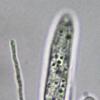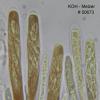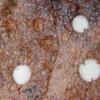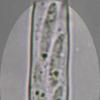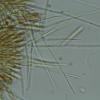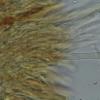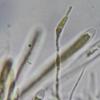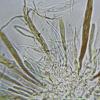
07-12-2025 16:07
Arnold BüschlenHallo, ich habe in einer Moos-Aufsammlung (epiohy

05-12-2025 17:33
 Bruno Coué
Bruno Coué
Bonjour, je serais heureux de recueillir votre avi

07-12-2025 09:24
De la pasada semana en Galicia EspañaEn el suelo

06-12-2025 00:19
 Viktorie Halasu
Viktorie Halasu
Hello, would anyone have this article, please? An

02-12-2025 18:59
This pair of ascos 2.5cm across were on recently b
Discomycète sp. # 50673
Roland Labbé,
17-03-2017 01:57
Voici un discomycète inconnu de nous.
Il se pourrait que ce soit un Hyaloscypha ?
Merci de nous aider à son identification.
Amitiés !
Roland
Données .
Substrat : feuille de hêtre, au sol
Apothécie : jusqu'à 0,36 mm de hauteur x 0,77 mm de diam., sessile
Asques cylindriques, à 8 spores bisériées, avec crochet basal et appareil apical inamyloïde, 41-47 x 4,7-6,4 µm
Paraphyses rares, filiformes, s'élargissant au tiers inférieur, septées à la base, 30,6-38,3 x 1,32-1,4 µm, plus courtes que les asques de 5-10 µm
Spores ellipsoïdes-cylindriques, avec septum médian difficile à préciser, lisses, avec 2-3 petites guttules, hyalines, réfringentes, 7,1-10,2 x 1,7-2,1 µm, Q = 4,3
Medulla formée de petites cellules polymorphes difficiles à préciser, hyalines
Excipulum en textura ± globulosa-angularis, formé de cellules à paroi modérément épaissie, 5,2-6,7 x 4,3-5,9 µm
Poils marginaux et externes longuement et progressivement effilés vers l'apex, septés au tiers inférieur, hyalins, réfringents, jusqu'à 180-200 x 3,2-4,8 µm vers la base et 0,9-2 µm vers l'apex
Hans-Otto Baral,
17-03-2017 07:45

Re : Discomycète sp. # 50673
Hi Roland
I am unaware of such a foliicolous species. Could be Hyaloscypha, but I remember only the lignicolous H. leuconica and H. bulbopilosa with such hairs, which also have amyloid asci.
Zotto
I am unaware of such a foliicolous species. Could be Hyaloscypha, but I remember only the lignicolous H. leuconica and H. bulbopilosa with such hairs, which also have amyloid asci.
Zotto
Kosonen Timo,
17-03-2017 12:34

Re : Discomycète sp. # 50673
Hello,
Can you provide a zoom on the hairs? Hyaloscypha -like appearance yes, but might be something "completely" else...
Timo
Roland Labbé,
17-03-2017 14:19
Kosonen Timo,
17-03-2017 14:38

Re : Discomycète sp. # 50673
That's interesting... I am in the lab, I have no notes here, but how about an Arachnopezizaceae with relatively small spores? For Hyaloscypha we would need to expand the generic limits a bit too much for what I know. ...another lovely creature!
Timo
Timo
Roland Labbé,
17-03-2017 16:12
Re : Discomycète sp. # 50673
Bonjour !
Nous avons une question pour vous.
Est-ce que les paraphyses peuvent germer en conidies ?
Nous avons des photos qui laissent supposer que c'est le cas.
Seriez-vous intéressés de voir ce que ces photos montrent ?
Merci et amitiés à vous Zotto et Timo !
Roland
Nous avons une question pour vous.
Est-ce que les paraphyses peuvent germer en conidies ?
Nous avons des photos qui laissent supposer que c'est le cas.
Seriez-vous intéressés de voir ce que ces photos montrent ?
Merci et amitiés à vous Zotto et Timo !
Roland
Hans-Otto Baral,
17-03-2017 16:37

Re : Discomycète sp. # 50673
Such conidial formation from paraphyses is usually impossible.
What could be is that a hymenial parasite invaded the apothecia.
Please show us pics.
Zotto
What could be is that a hymenial parasite invaded the apothecia.
Please show us pics.
Zotto
Roland Labbé,
17-03-2017 18:30
Hans-Otto Baral,
17-03-2017 19:06

Re : Discomycète sp. # 50673
I actually see only ascospores that germinate, and on the germ tubes may of course conidia be formed, though not in every group.
Roland Labbé,
17-03-2017 19:22
Re : Discomycète sp. # 50673
Merci Zotto !
Roland
Roland
Kosonen Timo,
17-03-2017 21:41

Re : Discomycète sp. # 50673
I'd like to see that (spores germinating) on an agar plate. Do you do DNA work over there? If you feel like sending material (fresh and/or dried) I wouldn't mind at all giving this one a try.
The lower part of the hair is peculiar. Is it just that some older hairs that have sunken in between the septa or is it a true character?
Anyway, truly multiseptate hairs (like these) are not considered to belong to Hyaloscypha, but maybe it is in Hyaloscyphaceae. Are those VBs in the paraphyses? Maybe it's just the ecology, put to me there is some Phialina in it. And I can't rule out Arachnopezizaceae either, there are some Hyaloscypha-like species over there. But really, just guessing.
Thanks for the post,
Timo
The lower part of the hair is peculiar. Is it just that some older hairs that have sunken in between the septa or is it a true character?
Anyway, truly multiseptate hairs (like these) are not considered to belong to Hyaloscypha, but maybe it is in Hyaloscyphaceae. Are those VBs in the paraphyses? Maybe it's just the ecology, put to me there is some Phialina in it. And I can't rule out Arachnopezizaceae either, there are some Hyaloscypha-like species over there. But really, just guessing.
Thanks for the post,
Timo
Hans-Otto Baral,
17-03-2017 22:53

Re : Discomycète sp. # 50673
You are right, Timo, hair septation would be very unusual in Hyaloscypha. Albotricha would be a genus to look, and Phialina. Whether VBs were present or not we cannot say. And the sunken wall between the septa is clearly due to the dead state of the hairs.
Is this collection from this month or perhaps even from last year?
Is this collection from this month or perhaps even from last year?
Roland Labbé,
17-03-2017 23:35
Re : Discomycète sp. # 50673
Date de la récolte : 15 / 10 / 2016
Roland
Roland

